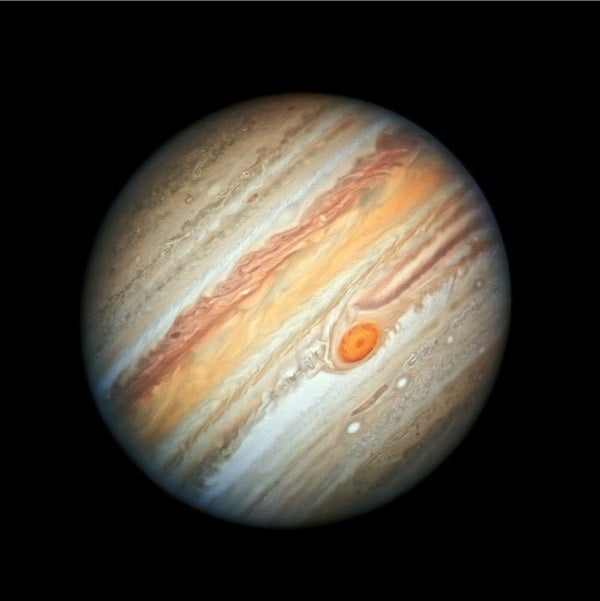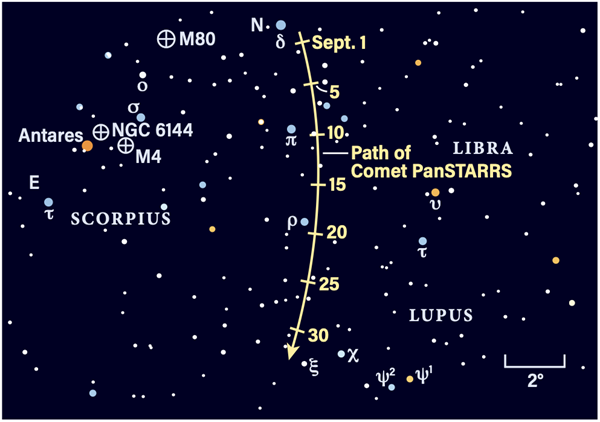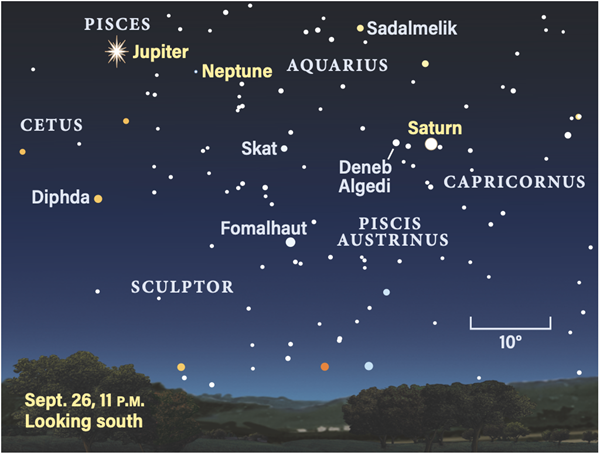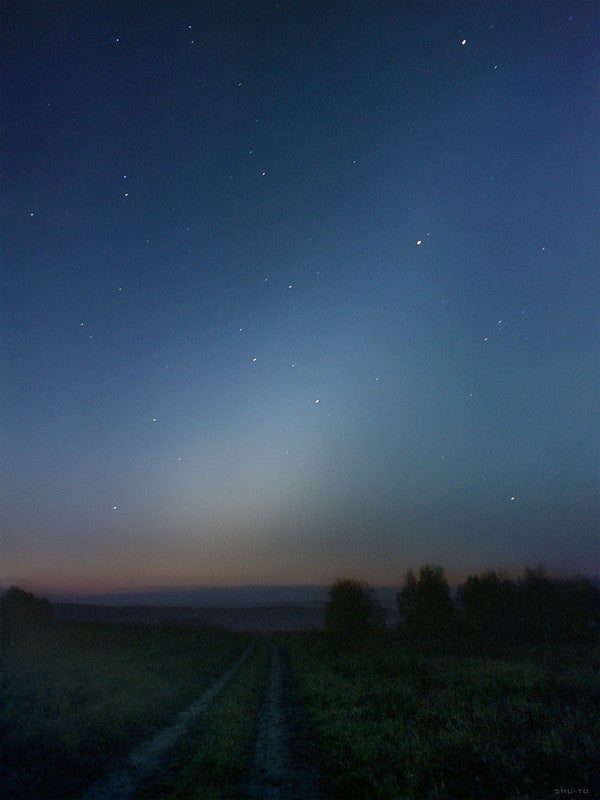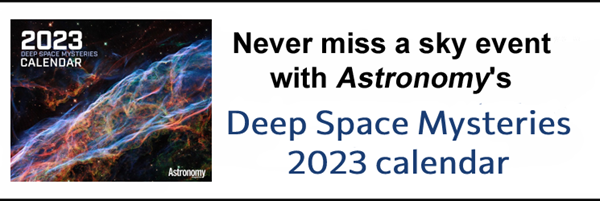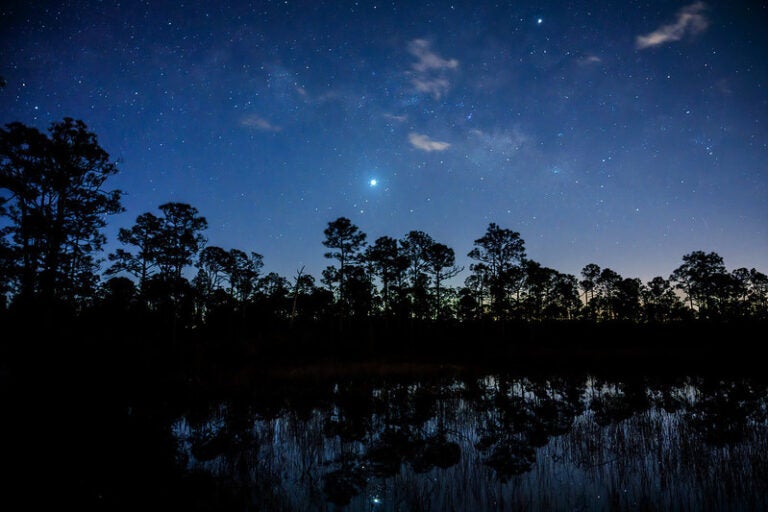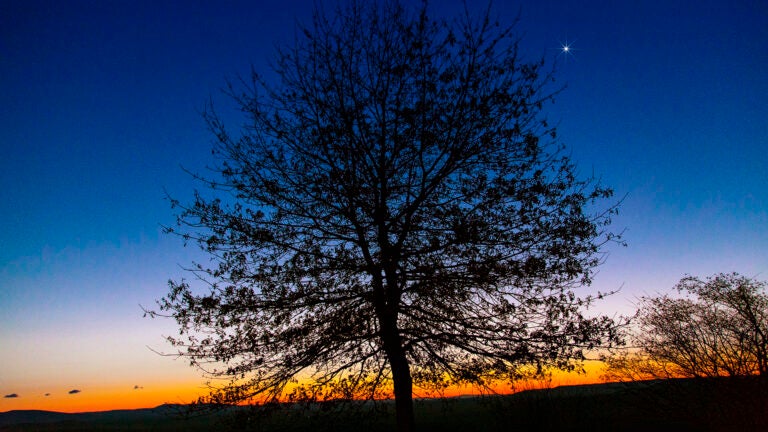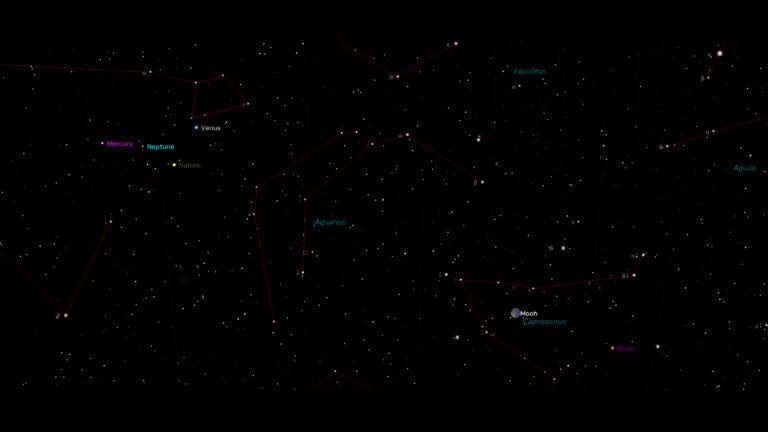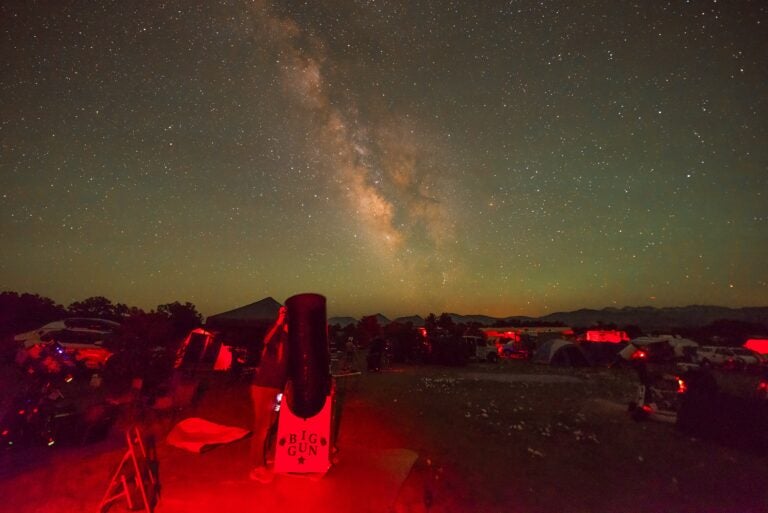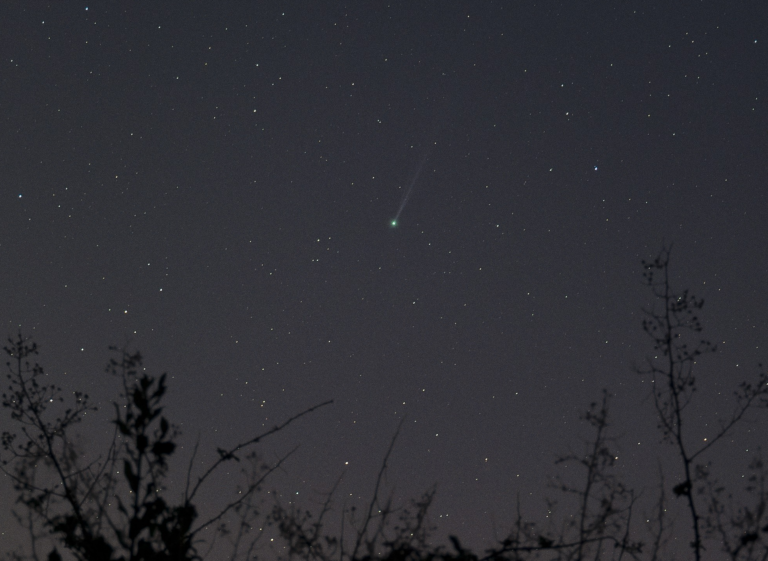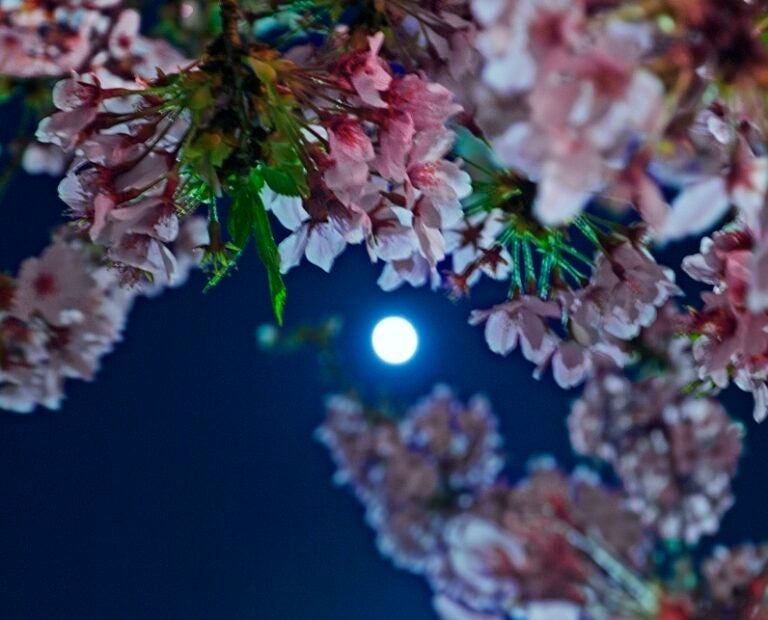Friday, September 23
Mercury reaches inferior conjunction at 3 A.M. EDT. But never fear, it won’t be gone for long — we’ll start to see it in the morning sky early next month.
A few hours before the Sun rises, Mars stands high in the southeast, adding its magnitude –0.5 light to Taurus the Bull. Don’t mistake it for nearby Aldebaran, located to Mars’ upper right (west) and is a bit fainter at magnitude 0.9. The Red Planet lies about halfway on a line drawn between golden-hued Aldebaran and blue-white magnitude 1.7 Elnath, which marks the end of one of the Bull’s two horns. (Zeta [ζ] Tauri, sometimes called Alheka, sits at the end of the other horn, to Elnath’s southeast.)
If the air is steady and you have a good-sized scope, you may be able to make out features on Mars’ surface, particularly with photography or high-speed video capture. The disk now appears 11″ across and will continue growing as time goes by, as the planet approaches opposition later this year. Shortly after local midnight in the Midwest, Mare Cimmerium is visible in the center of the disk and the dark spot of Syrtis Major and the lighter Hellas Basin are rotating on. The latter two should rest roughly midway across the disk some two hours before sunrise in the Midwest.
Sunrise: 6:49 A.M.
Sunset: 6:55 P.M.
Moonrise: 4:15 A.M.
Moonset: 6:18 P.M.
Moon Phase: Waning crescent (5%)
*Times for sunrise, sunset, moonrise, and moonset are given in local time from 40° N 90° W. The Moon’s illumination is given at 12 P.M. local time from the same location.
Saturday, September 24
Venus and the delicate crescent Moon create a lovely early-morning tableau shortly before sunrise this morning. Look east some 25 minutes before the Sun peeks above the horizon to see if you can spot Venus’ blazingly bright magnitude –3.9 glow. It’s just 1° above the horizon and rising as the sky grows brighter. About 9° directly above it is the 28-day-old Moon, now a 2-percent-lit waning crescent.
See if you can also spot 1st-magnitude Regulus 15.5° to the Moon’s upper right (west), fading into the background as twilight grows. You may more easily see Sirius, the Dog Star, some 30° high in the south. It will be the last star to fade from the sky, given its bright magnitude of –1.4.
If you opt to view Venus with a telescope, you’ll see that its disk appears fully lit and 10″ across. Take care to set an alarm for several minutes before the Sun rises in your location (which may differ from the time given below); at that time, put your telescope, binoculars, or any other optical instruments away to avoid serious damage to your eyes.
Sunrise: 6:49 A.M.
Sunset: 6:54 P.M.
Moonrise: 5:19 A.M.
Moonset: 6:42 P.M.
Moon Phase: Waning crescent (2%)
Sunday, September 25
New Moon occurs at 5:55 P.M. EDT. Shortly after dark, Comet C/2017 K2 PanSTARRS is still visible above the southwestern horizon, hanging beneath Scorpius’ front claws. Now in the constellation Lupus, the comet is losing altitude quickly for Northern Hemisphere observers even though its brightness is fairly good at magnitude 8.6. Even a small scope (and some patience) should net it for you, provided you have a clear view of the horizon with little to no light pollution present there.
You’ll find PanSTARRS now 2° south of Rho (ρ) Scorpii. It is just 12′ from the 6th-magnitude field star HIP 77985. The comet’s nucleus will likely look whitish and very compact — high powers are best for extended viewing. You may notice it is slightly elongated, with a sharper southern flank and a stubby, fan-shaped tail to the north as it’s battered by the solar wind.
If you have a large scope and a clear northern horizon, you can try to pick up 12th-magnitude Comet C/2020 V2 (ZTF), which is currently brightening in the north. It lies 4° below (south-southeast of) Merak, the star that marks the lower right-hand corner of the Big Dipper’s cup as viewed right-side up. This comet will continue brightening and slide up toward Polaris as the year goes on; we’ll definitely focus more on it in the months to come.
Sunrise: 6:50 A.M.
Sunset: 6:52 P.M.
Moonrise: 6:23 A.M.
Moonset: 7:05 P.M.
Moon Phase: New
Monday, September 26
The mighty planet Jupiter reaches opposition today at 4 P.M. EDT in the constellation Pisces. It will rise as the Sun sets and set as the Sun rises, offering excellent views all night and early morning.
Jupiter is also close to Earth in its orbit right now — closer than it has been since 1963, according to NASA. That’s because neither Jupiter nor Earth orbits the Sun in a perfect circle, and only occasionally do the planets’ orbits bring them particularly close together. But this year, the giant planet is within some 367 million miles (591 million kilometers) of Earth, making it appear particularly big and bright — 50″ across and magnitude –2.9 — in the sky.
Two hours after sunset, Jupiter is more than 20° high in the east. The later in the evening you observe, the better, as the clearer your views will be. You can’t miss its bright light some 11° below the Circlet of Pisces; Jupiter is the brightest source of light in the sky overnight, until Venus rises tomorrow morning.
Zoom in on Jupiter with a telescope and you’ll see it is flanked by its four largest moons. Stretching out to the east (from closest to farthest) are Io, Europa, and Ganymede. Alone to the west is Callisto. If you do catch the planet earlier in the evening, you may even see its Great Red Spot transiting the face, reaching the middle of the planet around 8:45 P.M. EDT. (The Spot will transit again tomorrow morning, reaching midway across Jupiter’s face around 6:40 A.M. EDT on the 27th.)
Sunrise: 6:51 A.M.
Sunset: 6:50 P.M.
Moonrise: 7:29 A.M.
Moonset: 7:28 P.M.
Moon Phase: Waxing crescent (1%)
Tuesday, September 27
The darkest nights this month are the best time to spot the far-flung ice giant Uranus, the second-to-last planet in our solar system. The magnitude 5.7 planet is an excellent binocular or small scope target tonight, rising in the east around 8 P.M. local time. Give it a few hours to climb higher above the horizon; by 11 P.M., it is more than 25° high in southeastern Aries. The planet will continue to move higher into the morning hours, so early risers can expect even better views.
The easiest way to find Uranus in binoculars is to first locate Menkar, Cetus the Whale’s magnitude 2.5 alpha star. From there, shift a little less than two fields of view (in 7×50 binoculars) to find a small triangle of three 6th-magnitude stars. One of these is 53 Arietis. Uranus sits near the western edge of the triangle. Its small disk spans just 4″ and may appear bluish-gray.
About 14.5° northeast of Uranus in the sky lies 2nd-magnitude Hamal, the brightest star in Aries. Roughly 4° southeast of this star is Aries’ second-brightest star, magnitude 2.6 Sheratan.
Sunrise: 6:52 A.M.
Sunset: 6:49 P.M.
Moonrise: 8:36 A.M.
Moonset: 7:53 P.M.
Moon Phase: Waxing crescent (4%)
Wednesday, September 28
Let’s return to Pisces tonight for a much fainter target than Jupiter. Today, we’re focusing on a galaxy group in the northeastern portion of the constellation, near Andromeda. Cataloged as Arp 331 or the NGC 383 group, this set of galaxies is sometimes called the Pisces Chain or the Pisces Cloud as well.
Even with a dark sky, you’ll need a large scope to track down this gaggle of galaxies, so go for as much aperture as you can. The brightest member of the chain is 12th-magnitude NGC 383, for whom the group is named. This galaxy also appears the largest, spanning some 2′. You’ll find it about 3.2° south of Mirach (Beta [β] Andromedae). Just 30″ to its southwest is the starlike galaxy NGC 382 (magnitude 14).
Stretching in a line southeast of NGC 383 are (from north to south) NGC 386 (magnitude 14), NGC 385 (magnitude 13), NGC 388 (magnitude 14), and NGC 384 (magnitude 13). To NGC 383’s north (from south to north) are NGC 380 (magnitude 13.6) and NGC 379 (magnitude 13).
Sunrise: 6:53 A.M.
Sunset: 6:47 P.M.
Moonrise: 9:46 A.M.
Moonset: 10:20 P.M.
Moon Phase: Waxing crescent (9%)
Thursday, September 29
Now that the Moon has disappeared from the evening sky, these last few days of the month are excellent for trying your hand at spotting the zodiacal light. Often called the false dawn at this time of year, the zodiacal light now appears in the east before sunrise, while the sky is still dark.
The best views will come from a high-up observing site with a clear view of the eastern horizon and little to no light pollution. Look for a soft, cone-shaped glow thrusting upward from the horizon in Leo and extending along the ecliptic, running through Cancer and Gemini as it narrows.
What causes this strange, almost otherworldly glow? It’s sunlight scattering off dust grains scattered throughout the inner solar system. These myriad grains have been sloughed off by comets as they round the Sun and warm up, leaving material behind.
Sunrise: 6:54 A.M.
Sunset: 6:45 P.M.
Moonrise: 10:58 A.M.
Moonset: 10:53 P.M.
Moon Phase: Waxing crescent (16%)
Friday, September 30
Saturn’s largest moon, Titan, sits due south of the ringed planet around 1 A.M. EST this morning (note that this is still late Thursday night for the western U.S.). The planet is low in the southwest at that time, sinking toward the horizon as Capricornus sets. Saturn, glowing at magnitude 0.4, is now 5° west of 3rd-magnitude Deneb Algedi.
It may be a bit challenging to get a clear image of the planet and magnitude 8.5 Titan, sitting about 40″ south of the planet’s limb, given the turbulence and thickness of Earth’s atmosphere. You may find that the planet is blurry and even appears to dance around. Still, if you’ve got a clear view of the horizon, give it a try.
Alternatively, you can come back to the scene this evening. An hour after sunset, Saturn is just over 25° high in the southeast, offering clearer, steadier views of the planet, its rings, and its moons. Now Titan sits roughly 1′ southwest of the planet’s limb and may be easier to spot. Through larger instruments, 10th-magnitude Tethys, Dione, and Rhea may also be visible. The first lies 30″ east of the planet’s center, while the other two lie 50″ and 1.3′ west of Saturn’s center, respectively.
Sunrise: 6:55 A.M.
Sunset: 6:44 P.M.
Moonrise: 12:11 P.M.
Moonset: 9:34 P.M.
Moon Phase: Waxing crescent (25%)

